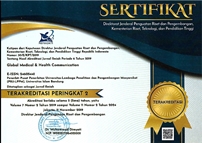Early Detection of the Heavy Metals Pollution Effect on Citarum River Using Zebrafish Muscle Mitochondria Biomarkers Gene Expression
Abstract
Keywords
Full Text:
PDFReferences
Bukit NT, Yusuf IA. Beban pencemaran limbah industri dan status kualitas air Sungai Citarum. J Teknol Lingkungan. 2002;3(2):98–106.
Sudarningsih, Bijaksana S. Karakteristik logam berat dan hubungannya terhadap parameter magnetik sedimen Sungai Citarum, sebagai studi awal kajian kemagnetan lingkungan di Sungai Citarum, Bandung Jawa Barat. Paper presented at the 7th National Conference Paleo, Rock and Environmental Magnetism (PREM); Bandung; 2020 May 26–27.
Budnik LT, Casteleyn L. Mercury pollution in modern times and its socio-medical consequences. Sci Total Environ. 2019;654:720–34.
Akpor OB, Ohiobor GO, Olaolu TD. Heavy metal pollutants in wastewater effluents: sources, effects and remediation. Adv Biosci Bioeng. 2014;2(4):37–43.
Jaishankar M, Tseten T, Anbalagan N, Mathew BB, Beeregowda KN. Beeregowda. Toxicity, mechanism and health effects of some heavy metals. Interdiscip Toxicol. 2014;7(2):60–72.
Kadeyala PK, Sannadi S, Gottipolu RR. Alterations in apoptotic caspases and antioxidant enzymes in arsenic exposed rat brain regions: reversal effect of essential metals and a chelating agent. Environ Toxicol Pharmacol. 2013;36(3):1150–66.
Liu T, He W, Yan C, Qi Y, Zhang Y. Roles of reactive oxygen species and mitochondria in cadmium-induced injury of liver cells. Toxicol Ind Health. 2011;27(3):249–56.
Sousa CA, Soares EV. Mitochondria are the main source and one of the targets of Pb (lead)-induced oxidative stress in the yeast Saccharomyces cerevisiae. Appl Microbiol Biotechnol. 2014;98(11):5153–60.
Dwivedi N, Mehta A, Yadav A, Binukumar BK, Gill KD, Flora SJS. MiADMSA reverses impaired mitochondrial energy metabolism and neuronal apoptotic cell death after arsenic exposure in rats. Toxicol Appl Pharmacol. 2011;256(3):241–8.
Prakash C, Soni M, Kumar V. Biochemical and molecular alterations following arsenic-induced oxidative stress and mitochondrial dysfunction in rat brain. Biol Trace Elem Res. 2015;167(1):121–9.
Ma L, Liu JY, Dong JX, Xiao Q, Zhao J, Jiang FL. Toxicity of Pb2+ to rat liver mitochondria induced by oxidative stress and mitochondrial permeability transition. Toxicol Res (Camb). 2017;6(6):822–30.
Prakash C, Soni M, Kumar V. Mitochondrial oxidative stress and dysfunction in arsenic neurotoxicity: a review. J Appl Toxicol. 2016;36(2):179–88.
Liu Z, Zhou T, Ziegler AC, Dimitrion P, Zuo L. Oxidative stress in neurodegenerative diseases: from molecular mechanisms to clinical applications. Oxid Med Cell Longev. 2017;2017:2525967.
Arini A, Gourves PY, Gonzalez P, Baudrimont M. Metal detoxification and gene expression regulation after a Cd and Zn contamination: an experimental study on Danio rerio. Chemosphere. 2015;128:125–33.
Chang KC, Hsu CC, Liu SH, Su CC, Yen CC, Lee MJ, et al. Cadmium induces apoptosis in pancreatic β-cells through a mitochondria-dependent pathway: the role of oxidative stress-mediated c-Jun N-terminal kinase activation. PLoS One. 2013;8(2):e54374.
Liu W, Yang T, Xu Z, Xu B, Deng Y. Methyl-mercury induces apoptosis through ROS-mediated endoplasmic reticulum stress and mitochondrial apoptosis pathways activation in rat cortical neurons. Free Radic Res. 2019;53(1):26–44.
Kopp R, Bauer I, Ramalingam A, Egg M, Schwerte T. Prolonged hypoxia increases survival even in zebrafish (Danio rerio) showing cardiac arrhythmia. PLoS One. 2014;9(2):e89099.
Matthews M, Varga ZM. Anesthesia and euthanasia in zebrafish. ILAR J. 2012;53(2):192–204.
Wilson JM, Bunte RM, Carty AJ. Evaluation of rapid cooling and tricaine methanesulfonate (MS222) as methods of euthanasia in zebrafish (Danio rerio). J Am Assoc Lab Anim Sci. 2009;48(6):785–9.
Nkinda MS, Rwiza MJ, Ijumba JN, Njau KN. Heavy metals risk assessment of water and sediments collected from selected river tributaries of the Mara river in Tanzania. Discov Water. 2021;1(1):3.
Shanbehzadeh S, Vahid Dastjerdi M, Hassanzadeh A, Kiyanizadeh T. Heavy metals in water and sediment: a case study of Tembi river. J Environ Public Health. 2014;2014:858720.
Zhang C, Yu ZG, Zeng GM, Jiang M, Yang ZZ, Cui F, et al. Effects of sediment geochemical properties on heavy metal bioavailability. Environ Int. 2014;73:270–81.
Simpson SL, Maher EJ, Jolley DF. Processes controlling metal transport and retention as metal-contaminated groundwaters efflux through estuarine sediments. Chemosphere. 2004;56(9):821–31.
Bose-O'Reilly S, McCarty KM, Steckling N, Lettmeier B. Mercury exposure and children’s health. Curr Probl Pediatr Adolesc Health Care. 2010;40(8):186–215.
Pang D, Yang C, Luo Q, Li C, Liu W, Li L, et al. Soy isoflavones improve the oxidative stress induced hypothalamic inflammation and apoptosis in high fat diet-induced obese male mice through PGC1-alpha pathway. Aging (Albany NY). 2020;12(9):8710–27.
Butterick TA, Hocum Stone L, Duffy C, Holley C, Cabrera JA, Crampton M, et al. Pioglitazone increases PGC1-α signaling within chronically ischemic myocardium. Basic Res Cardiol. 2016;111(3):37.
Gonzalez P, Dominique Y, Massabuau JC, Boudou A, Bourdineaud JP. Comparative effects of dietary methylmercury on gene expression in liver, skeletal muscle, and brain of the zebrafish (Danio rerio). Environ Sci Technol. 2005;39(11):3972–80.
Bourdineaud JP, Bellance N, Bénard G, Brèthes D, Fujimura M, Gonzalez P, et al. Feeding mice with diets containing mercury-contaminated fish flesh from French Guiana: a model for the mercurial intoxication of the Wayana Amerindians. Environ Health. 2008;7:53.
DOI: https://doi.org/10.29313/gmhc.v13i1.14110
pISSN 2301-9123 | eISSN 2460-5441
Visitor since 19 October 2016:
Global Medical and Health Communication is licensed under a Creative Commons Attribution-NonCommercial-ShareAlike 4.0 International License.































.png)
_(1).png)
_(1).jpg)
